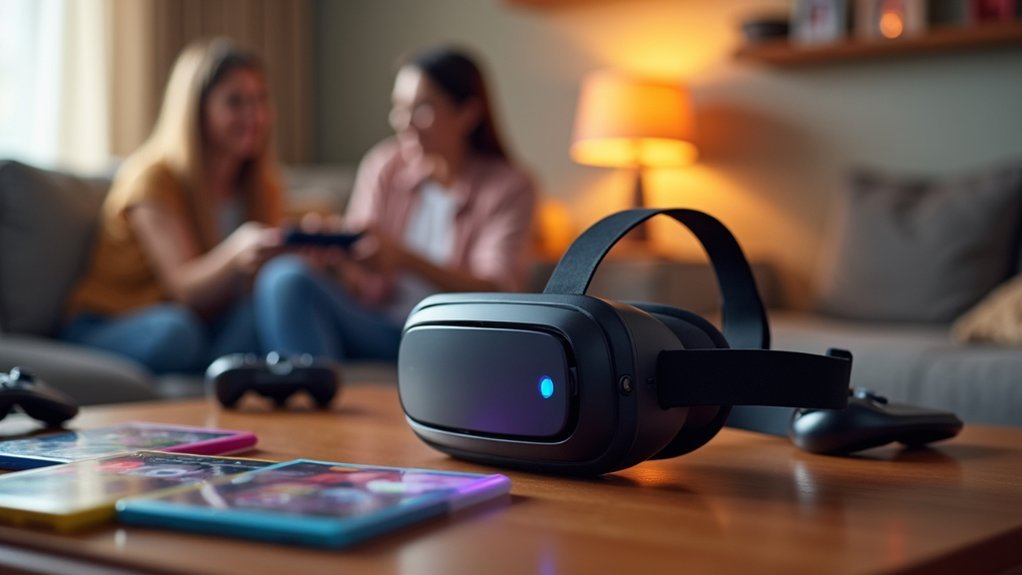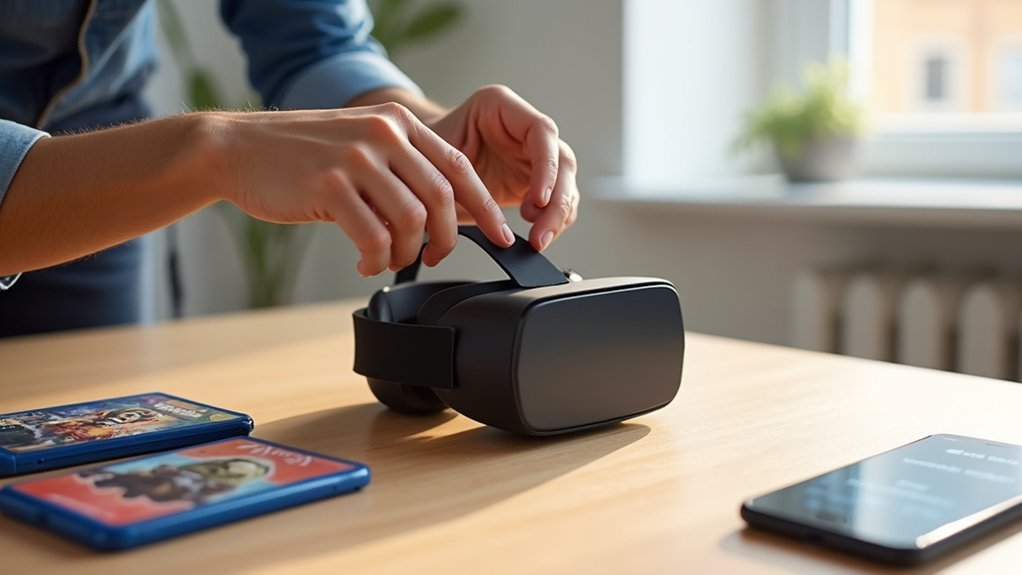Standalone headsets eliminate every technical barrier that intimidates VR newcomers. You’ll get an all-in-one device with built-in processors, displays, and tracking that works immediately without expensive gaming computers or complex setups. You simply charge the headset, connect to Wi-Fi, and you’re exploring virtual worlds within minutes. The wireless design prevents cable tangles, while beginner-friendly content libraries guarantee you won’t feel overwhelmed. Discover how these advantages make standalone VR your perfect entry point.
Understanding Standalone VR Technology and How It Works

Revolutionary simplicity defines standalone VR headsets, which pack everything you need for virtual reality into a single device. You don’t need computers, consoles, or external sensors—these stand-alone VR headsets contain built-in processors, displays, and batteries that power your entire VR experience.
The magic happens through inside-out tracking technology. Cameras mounted on your headset map your environment and track your movements in real-time. You’ll move freely around your space without worrying about cables or setting up tracking equipment.
Your headset comes with two ergonomic controllers that make interactions intuitive and user-friendly. This wireless setup eliminates complexity that often intimidates newcomers.
You simply put on the headset, grab the controllers, and plunge into immersive experiences immediately. Everything works together seamlessly, making virtual reality accessible for everyone.
No External Hardware Required: True Plug-and-Play Experience
This seamless integration means you’ll literally unbox your headset and start exploring virtual worlds within minutes.
Standalone headsets eliminate the frustration of complex setups that traditionally plague VR newcomers. You won’t need to worry about connecting multiple devices or troubleshooting compatibility issues.
Standalone VR headsets remove technical barriers, letting newcomers dive into virtual reality without wrestling with complicated hardware configurations or connectivity problems.
The true plug-and-play experience includes:
- Built-in processing power that handles all computations internally
- Integrated tracking sensors for accurate movement detection
- Self-contained display technology requiring no external monitors
- User-friendly interfaces designed for immediate navigation
- Simple Wi-Fi connectivity without additional hardware requirements
You’ll simply charge your device, connect to your local network, and you’re ready to engage.
This eliminates external hardware dependencies that often intimidate beginners, making standalone headsets the perfect introduction to virtual reality gaming and experiences.
Budget-Friendly Entry Point Into Virtual Reality Gaming

You don’t need to break the bank to experience virtual reality gaming with standalone headsets that cost between $200-$500.
Unlike PC-powered VR systems that can exceed $1,000, these devices eliminate the need for expensive gaming computers or additional hardware investments.
You’ll save even more money since many headsets like the Meta Quest 3 come with built-in games and apps, reducing your initial software costs.
Affordable Hardware Requirements
While high-end VR systems can cost thousands of dollars when you factor in powerful gaming PCs, standalone headsets offer an accessible entry point at just $200 to $500.
You won’t need expensive additional equipment since these devices operate independently with minimal hardware requirements.
These affordable standalone headsets provide everything you need to immerse yourself in VR games immediately:
- No gaming PC required – saves you over $1,000 in computer hardware costs
- Essential accessories included with popular models like Meta Quest 2 and Pico 4
- Quick setup process requiring minimal time investment
- Access to diverse VR game libraries without financial barriers
- User-friendly design perfect for beginners
You can start your virtual reality journey without breaking the bank, making standalone headsets the perfect entry point for newcomers seeking affordable gaming experiences.
Minimal Setup Costs
Three key factors make standalone headsets the most budget-conscious choice for VR newcomers.
First, you’ll spend considerably less upfront, with standalone headsets ranging from $200 to $500 compared to PC-powered systems exceeding $1,000 when including computer costs.
Second, minimal setup requirements mean you won’t need additional hardware purchases beyond the headset and included controllers – everything’s provided for a complete VR experience out of the box.
Third, you’ll avoid ongoing accessory expenses that typically burden other VR systems.
This budget-friendly approach eliminates the financial barriers that often prevent newcomers from exploring virtual reality.
With such beginner-friendly pricing and minimal setup costs, you can immediately plunge into VR gaming without breaking your budget or dealing with complex equipment purchases.
No PC Investment
Since standalone VR headsets don’t require a gaming PC, you’ll bypass one of the biggest financial barriers in virtual reality.
Traditional PCVR setups demand powerful computer hardware that can cost thousands of dollars, but standalone headsets eliminate this expense entirely.
This no pc investment approach makes virtual reality genuinely budget-friendly for newcomers. You’ll enjoy a seamless user experience without the complexity of PC compatibility requirements or hardware upgrades.
Key advantages of standalone headsets include:
- Independent operation without external computer dependencies
- Pricing between $200-$500 versus $1,000+ for PCVR systems
- Immediate plug-and-play functionality
- No graphics card or processor upgrade requirements
- Simplified troubleshooting and maintenance
Simple Setup Process That Takes Minutes, Not Hours

When you unbox a standalone VR headset, you’ll discover that getting started takes just minutes rather than the hours typically required for PC-based setups.
The simple setup process involves charging your device and connecting to your local network—that’s it. Standalone headsets utilize minimal setup requirements since they don’t need external sensors or complicated hardware configurations.
You’ll benefit from built-in tracking and sensors that eliminate the need for additional equipment installation.
The headset’s software guides you through intuitive step-by-step tutorials, making navigation effortless even if you’re a complete beginner.
Most devices come with pre-installed apps and games, so you can immediately plunge into VR experiences without waiting for downloads or additional purchases.
Wireless Freedom Eliminates Tangled Cables and Movement Restrictions
Beyond the quick setup, standalone headsets deliver complete wireless freedom that transforms your VR experience.
You’ll never deal with tangled cables dragging behind you or limiting where you can move.
This wireless freedom creates truly immersive VR by letting you:
- Move naturally in any direction without cord restrictions
- Play in different rooms or locations effortlessly
- Avoid tripping hazards that come with tethered systems
- Set up gaming spaces anywhere without worrying about cable length
- Focus entirely on your virtual world instead of managing wires
Standalone headsets like the Meta Quest 3 and Pico 4 give you complete freedom of movement that enhances immersion dramatically.
You can duck, dodge, and explore virtual environments exactly as you’d in real life, making your VR adventures feel genuinely authentic.
Built-In Processing Power Means No Computer Compatibility Worries
You won’t need to worry about whether your computer can handle VR gaming since standalone headsets pack all the processing power right into the device.
There’s no need to check system requirements, upgrade your graphics card, or troubleshoot compatibility issues that often frustrate newcomers.
Simply unbox your headset, charge it up, and you’re ready to jump into virtual reality within minutes.
No PC Requirements
Since standalone VR headsets like the Meta Quest 3 and Pico 4 pack all their processing power internally, you won’t need to worry about PC compatibility issues that often intimidate newcomers.
These no pc requirements devices eliminate technical barriers that traditionally made virtual reality inaccessible to beginners.
Standalone headsets with built-in processing power offer distinct advantages:
- No expensive gaming computer purchases required
- Zero hardware compatibility research needed
- Instant setup without cable management hassles
- No graphics card or CPU specification concerns
- Freedom from driver updates and system conflicts
You’ll find these easy to use systems ready for virtual reality experiences straight from the box.
Simply charge your headset, connect to Wi-Fi, and start exploring VR worlds immediately.
This streamlined approach removes the intimidation factor that complex PC setups often create for newcomers.
Simple Setup Process
When you unbox a standalone VR headset, the entire setup process typically takes under a minute.
You’ll simply charge the device and connect it to your local Wi-Fi network—that’s it. Unlike traditional virtual reality systems that require extensive hardware configurations, standalone headsets eliminate compatibility headaches entirely.
The simple setup process makes these devices perfect for any beginner who wants immediate access to VR experiences.
You won’t wrestle with PC requirements, external sensors, or complex cable management. Instead, you’ll find intuitive interfaces and step-by-step tutorials that guide you through everything seamlessly.
This user-friendly experience means you can dive straight into gaming and exploration without technical barriers.
Standalone headsets truly deliver on their promise of hassle-free virtual reality for newcomers.
Comfortable Design Features for Extended Gaming Sessions
Key comfort features include:
Comfort-focused design elements ensure extended VR sessions remain enjoyable without fatigue or discomfort.
- Ergonomic shapes that distribute weight evenly across your head, reducing pressure points
- Cushy foam padding that cushions your face and creates a soft barrier between skin and hardware
- Adjustable straps that accommodate different head sizes and face shapes for personalized fit
- Lightweight construction at approximately 513 grams to minimize neck strain
- Enhanced ventilation and airflow systems that prevent overheating during prolonged use
- Beat Saber – rhythm-based gameplay that’s instantly intuitive
- Job Simulator – humorous workplace scenarios with easy controls
- 360-degree video experiences for passive exploration
- Interactive applications designed specifically for newcomers
- Educational content that teaches VR navigation fundamentals
- Beat Saber provides simple rhythm-based mechanics that build hand-eye coordination
- Superhot VR introduces slow-motion combat perfect for beginners
- Guided tutorials walk you through controls step-by-step
- Intuitive interfaces make navigation effortless from day one
- Regular content updates guarantee fresh experiences tailored to your skill level
- Minimal setup – Simply charge and connect to your local network
- No external hardware – Operates independently without powerful computers
- User-friendly interfaces – Intuitive controls with step-by-step tutorials
- Ergonomics – Comfortable design like the PICO 4 for extended sessions
- Curated selection – Smaller, manageable game library prevents overwhelm
These thoughtful design elements guarantee you’ll stay comfortable throughout your VR adventures.
User-Friendly Interface and Intuitive Controller Systems
Simplicity forms the foundation of standalone VR headsets, where manufacturers have prioritized intuitive design over complex button layouts. When you’re exploring your Meta Quest 3 or Pico 4, you’ll discover that the user-friendly interface guides you effortlessly through menus and settings, eliminating the confusion that typically overwhelms beginners.
The intuitive controller systems feature minimal buttons, allowing you to master controls quickly without memorizing complicated combinations.
You’ll appreciate how standalone headsets streamline your VR journey with step-by-step tutorials that walk you through setup processes. The built-in sensors automatically handle room tracking, removing the need for external hardware setup.
Meanwhile, wireless functionality frees you from tangled cords, letting you move naturally while gaming. This thoughtful design approach guarantees you’ll spend more time enjoying VR experiences rather than struggling with technical complexities.
Growing Content Library Tailored for Newcomers
You’ll find that standalone headsets now offer an impressive selection of beginner-friendly games specifically designed to ease you into VR without overwhelming complexity.
These platforms provide simple setup tutorials that walk you through basic controls and movements, ensuring you’re comfortable before jumping into gameplay.
Most importantly, the content libraries are structured with gradual complexity progression, allowing you to build your VR skills naturally as you explore more challenging experiences over time.
Beginner-Friendly Game Selection
One major advantage of standalone headsets lies in their carefully curated game libraries that welcome VR newcomers with open arms.
These beginner-friendly games feature simplified mechanics and extensive tutorials that’ll help you master VR environments without overwhelming complexity.
Popular titles available on standalone headsets include:
Your content library receives regular updates, ensuring fresh experiences tailored to beginners.
These carefully selected titles focus on gradual skill building rather than challenging gameplay, making your first VR experiences enjoyable and confidence-building rather than frustrating or disorienting.
Simple Setup Tutorials
Getting started with standalone VR headsets requires minimal technical expertise thanks to their intuitive setup tutorials that walk you through each step in under a minute.
You’ll find the user-friendly interface guides you seamlessly from unboxing to your first VR experience. The wireless design eliminates complicated cable management that often intimidates newcomers to technology.
These headsets come pre-loaded with simple apps and games specifically designed for beginners, ensuring you won’t feel overwhelmed by complex navigation systems.
The streamlined setup process means you can dive straight into immersive experiences without technical hurdles. You’ll gain quick access to entertainment that introduces VR concepts gradually, building your confidence naturally.
This approach transforms what could be a challenging technological leap into an accessible and enjoyable journey into virtual reality.
Gradual Complexity Progression
Beyond the initial setup experience, standalone headsets excel at introducing content that matches your evolving comfort level with VR technology.
You’ll find user-friendly games designed specifically to help you gradually acclimate to virtual environments without overwhelming complexity.
Popular platforms offer engaging gameplay that grows with your skills:
This diverse range of experiences means you’re never stuck in one difficulty zone.
As your confidence builds, you can seamlessly shift to more advanced titles or even connect to PC platforms for expanded libraries.
Portability Advantages for Gaming Anywhere
While traditional VR systems tether you to a powerful computer in a single room, standalone headsets like the Meta Quest 3 and Pico 4 break those chains entirely.
Their portability lets you slip them into your backpack and game virtually anywhere—from friends’ houses to outdoor spaces. You’ll appreciate the wireless design that eliminates cord tangles while giving you complete freedom of movement during gaming sessions.
At just 500 grams, these headsets won’t strain your neck during extended play. The quick setup means you’re gaming in under a minute, perfect when you want instant entertainment.
Lightweight 500-gram design prevents neck fatigue while sub-minute setup delivers instant gaming satisfaction for spontaneous VR sessions.
Built-in batteries deliver 2-3 hours of playtime, ideal for commutes or breaks. This mobility transforms VR from a stationary experience into something you can enjoy wherever inspiration strikes, making these headsets incredibly beginner-friendly.
Lower Technical Knowledge Requirements Compared to PC VR
Unlike PC VR systems that demand technical expertise to configure graphics cards, adjust display settings, and troubleshoot compatibility issues, standalone headsets eliminate these barriers entirely.
You’ll appreciate how lower technical knowledge requirements make VR accessible to everyone.
Standalone headsets simplify your VR journey through:
You won’t need to adjust multiple components or understand complex technical specifications.
The straightforward approach guarantees you’re gaming within minutes rather than hours of configuration.
Future-Proof Investment as Standalone Technology Advances
When you invest in a standalone headset like the PICO 4, you’re positioning yourself to benefit from continuous technological evolution without expensive hardware upgrades. These future-proof devices receive regular software updates that enhance performance and add new features, making your investment more valuable over time.
| Advancement Area | Current Benefits | Future Potential |
|---|---|---|
| Graphics Quality | Decent visuals | PCVR-level graphics |
| Processing Power | Efficient performance | Enhanced capabilities |
| Content Library | Growing selection | Extensive catalog |
As standalone technology advances, you’ll experience improved graphics quality and processing power that narrows the gap with PCVR experiences. The expanding game library ensures fresh content, while emerging technologies like enhanced tracking and mixed reality capabilities will upgrade your headset’s functionality automatically through updates.
Frequently Asked Questions
What Is a Good Beginner VR Headset?
You should consider the Meta Quest 3S as your first VR headset. It’s affordably priced at $300, requires minimal setup, offers wireless freedom, and provides access to extensive game libraries for beginners.
What to Consider When Buying a VR Headset?
You’ll want to contemplate your budget, available play space, content library preferences, comfort and fit requirements, and setup complexity when choosing a VR headset that matches your gaming needs.
How Do Standalone VR Headsets Work?
You’ll find standalone VR headsets contain all components internally – processor, display, battery, and sensors. They use inside-out tracking to monitor your movements and controllers wirelessly, letting you download apps directly without needing external computers.
What Is VR Like for the First Time?
You’ll feel completely transported into another world, experiencing overwhelming sensations as realistic 3D environments surround you. Your brain initially struggles processing this new reality, creating excitement and disorientation simultaneously.





Leave a Reply